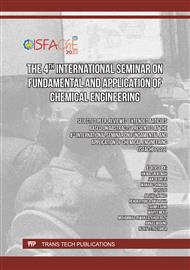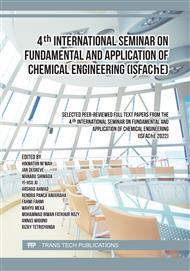[1]
Djenar N.S., Jayanti, R.D., Suryadi J. (2021). The Effect of Sodium Chloride with Varying Concentration on Characteristics and Rheology of Extracted Gluten from Wheat Flour. Advances in Engineering Research Proceedings of the 2nd International Seminar of Science and Applied Technology (ISSAT 2021)
DOI: 10.2991/aer.k.211106.004
Google Scholar
[2]
Nadeem.M.et all. 2016. Electrophoretic characteristics of gluten protein as influenced by Crop Year and Variety. International Journal of Food Properties, 19 (2016) 897-910
DOI: 10.1080/10942912.2015.1045518
Google Scholar
[3]
Andresa C. Ribeiro,et al, Structural study of wheat gliadin in different solvents by spectroscopic techniques. J. Braz. Chem. Soc., 32.4 (2021) 695-70.
Google Scholar
[4]
Dengfeng Peng et al, Foaming and surface rheological behaviors of gliadin particles: Effect of solvent and concentration of gliadin stock solution, J. Food Hydrocolloids 106 (2020) 105868 ELSEVIER.
DOI: 10.1016/j.foodhyd.2020.105868
Google Scholar
[5]
Joye et al. Gliadin-based Nanoparticles: Stabilization by Post-production Polysaccharide Coating, J.Food Hydrocolloids (2014)
DOI: 10.1016/j.foodhyd.2014.05.021
Google Scholar
[6]
Muhammad Gulfam, Ji-eun Kim, Anticancer drug-loaded gliadin nanoparticles induce apoptosis in breast cancer cells, ACS Publication 2012 American Chemical Society.
DOI: 10.1021/la300691n
Google Scholar
[7]
Narendra Reddy, developing water stable gliadin films without using crosslinking agents, Journal of Polymers and the Environment 18 (2010), p.277–283;.
DOI: 10.1007/s10924-010-0193-0
Google Scholar
[8]
Kyoungwon Cho et al. Proteomic Profiling and Epitope Analysis of the Complex a-, g-, and &-Gliadin Families in a Commercial Bread Wheat. Frontiers in Plant Science, Original research 2018 volume 9.
Google Scholar
[9]
Raashid Ahmad Siddiqi et al, Electrophoretic characterization and proportion of different protein fractions in wheat cultivars of North-India. Journal of Agriculture and Food Research 4 (2021) 100137 ELSEVIER.
DOI: 10.1016/j.jafr.2021.100137
Google Scholar
[10]
Rani, M., Sogi, D.S., & Gill, B.S., Characterization of gliadin, secalin and hordein using advance analytical techniques. Scientific Reports | (2021) 11:23135 | https://doi.org/
DOI: 10.1038/s41598-021-02099-0
Google Scholar
[11]
Vesna S. Gojković Cvjetković et al, Gliadin analysis by Reversed-phase high performance liquid chromatography, Advanced technologies. 8(2) (2019) 30-36.
DOI: 10.5937/savteh1902030g
Google Scholar
[12]
Wieser, H., Seilmeier, W., & Belitz, H.-D, Quantitative determination of gliadin subgroups from different wheat cultivars. Journal of Cereal Science, 19(2) (1994) 149–155
DOI: 10.1006/jcrs.1994.1020
Google Scholar
[13]
Bassi, S., Maningat, C., C., Chinnaswamy, R., Gray, D., R., & Nie.L, U.S. Patent No. 10260 (1997)
Google Scholar
[14]
Gabler, A. M. & Khatarina, A. S. Comparative Characterization of Gluten and Hydrolyzed Wheat Proteins. Technical University of Munich, Germany (2020)
Google Scholar
[15]
Schalk, K., Lexhaller, B., Koehler, P., & Scherf, K. A, Isolation and characterization of gluten protein types from wheat, rye, barley and oats for use as reference materials. J. PLOS ONE, 12(2), (2017) e0172819.
DOI: 10.1371/journal.pone.0172819
Google Scholar
[16]
Socha, P., Tomka, M., Kačmárová, K., Lavová, B., Ivanišová, E., Mickowska, B., & Urminská, D, Comparable efficiency of different extraction protocols for wheat and rye prolamins. Potravinarstvo Slovak Journal of Food Sciences, 10(1), (2016) 139–144.
DOI: 10.5219/540
Google Scholar
[17]
Wieser, H, Chemistry of gluten proteins, Food Microbiology, 24(2), (2007). 115–119.
Google Scholar
[18]
F. Nada (2019) Ekspresi Gen Sintetik pengkode virus chikungunya (scFv-CHIKV) pada Escherichia coli BL21 (DE3). Universitas Padjadjaran, Bandung.
Google Scholar
[19]
Kaushik. et al, Isolation, characterization of wheat gluten and its regeneration properties. J Food Sci Technol. (2014).
DOI: 10.1007/s13197-014-1690-2
Google Scholar
[20]
Markus Schmid, Tobias K. Prinz et al, Effect of sodium sulfite, sodium dodecyl sulfate, and urea on the molecular interactions and properties of whey protein isolate-based films, Frontiers in Chemistry. Original Research (2017)
DOI: 10.3389/fchem.2016.00049
Google Scholar
[21]
Novák, P., & Havlíček, V, Protein extraction and precipitation. Proteomic profiling and analytical chemistry 51–62. Elsevier.51-62, 2016
DOI: 10.1016/B978-0-444-63688-1.00004-5
Google Scholar
[22]
Gold Biotechnology (https://www.goldbio.com/articles/article/TCEP-the-Reducing-Agent
Google Scholar
[23]
Kong dan Yu. (2007). Fourier Transform Infrared Spectroscopic Analysis of Protein Secondary Structures. Shanghai. Departement of Chemistry. Fudan University.
Google Scholar
[24]
Rekowski A. Wimmer Monika A. et al, Drought stress during anthesis alters grain protein composition and improves bread quality in field-grown Iranian and German wheat genotypes, Appl. Sci. 2021. 11. 9782. https://doi.org/10.3390/ app11219782
DOI: 10.3390/app11219782
Google Scholar
[25]
Garg Swati, Cranz Marlene J. & Mishra V. K., Effect of heating and acidic pH on characteristics of wheat gluten suspension, International Journal of Food Science and Technology (2019).
Google Scholar



